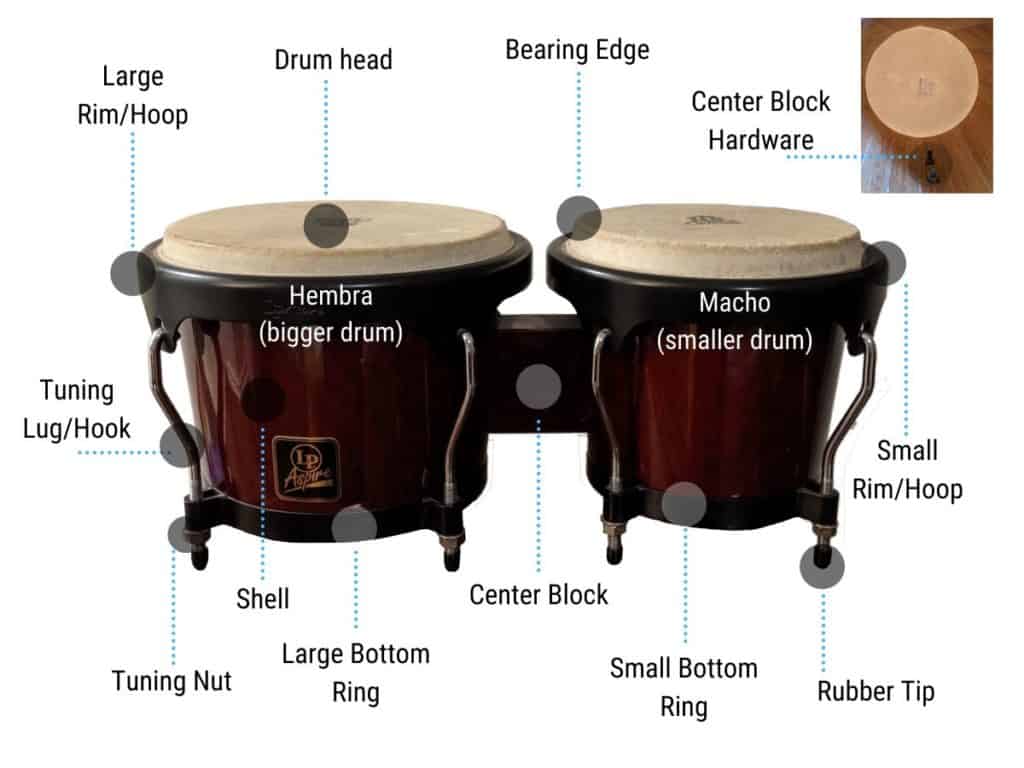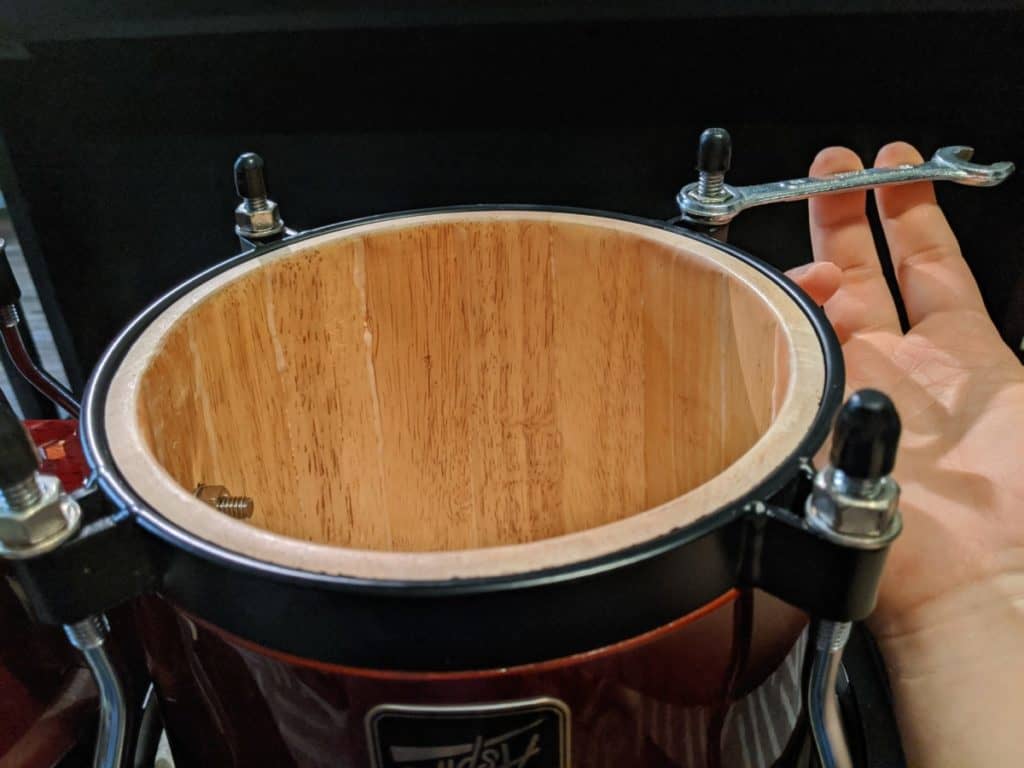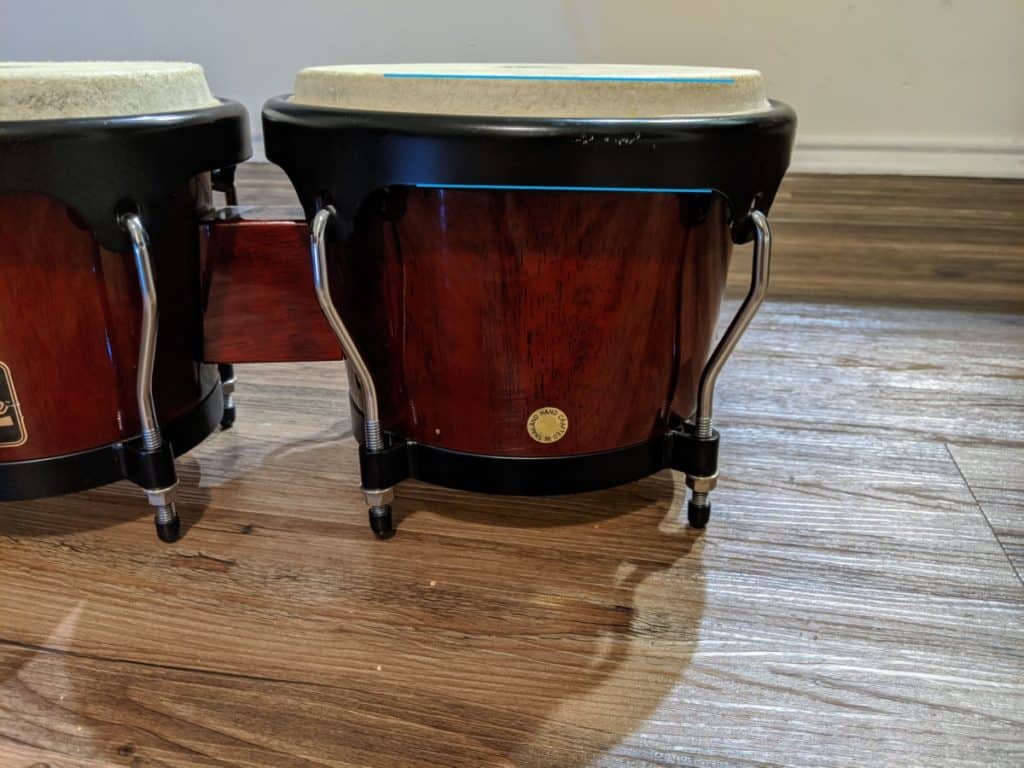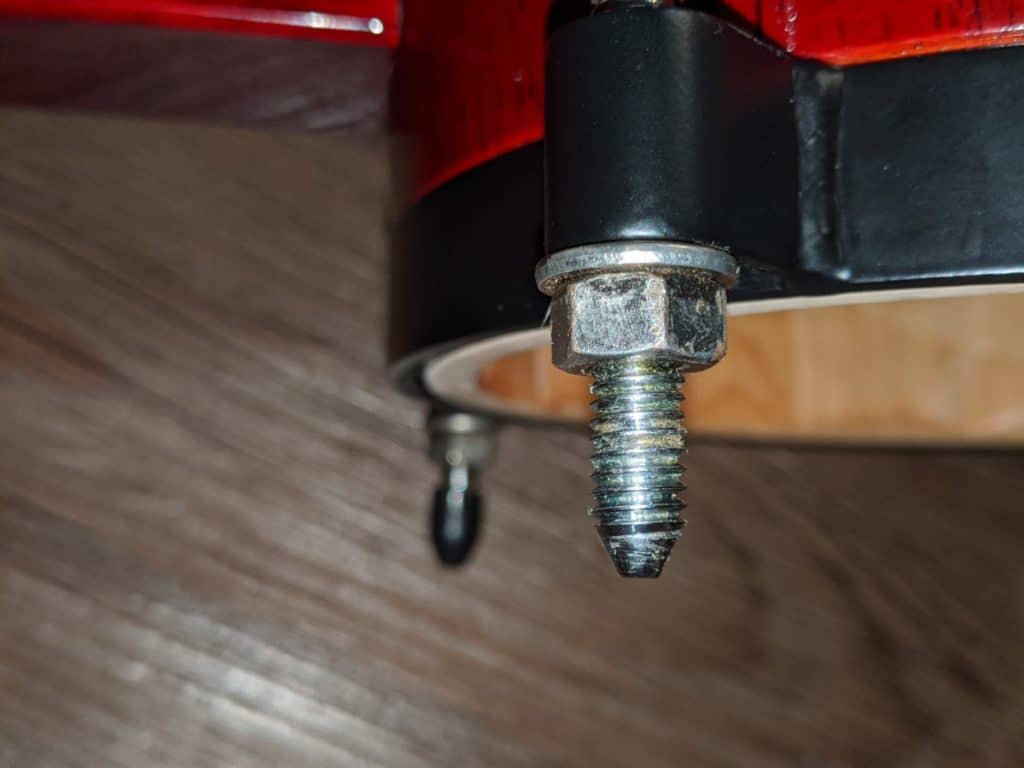This post contains affiliate links. We earn commissions if you purchase products from retailers after clicking on a link from our site. As an Amazon Associate, we earn from qualifying purchases.
Believe it or not, there’s a lot to know about tuning bongos. Ultimately tuning is a personal choice and the pitches that you choose to tighten your drumheads are up to you. However, everyone will thank you if you tune your bongos properly.
Tuning your bongos properly requires tightening the tuning lugs evenly, finding the ideal pitch and resonance for the high drum (macho), determining the proper interval between the high and low drum, and lastly, tuning technique.
Let’s get to it! I’ll try and break this up into all the sections that you need to know and try to make it easy to jump to what you’re looking for.
Lightning Quick Bongo Terminology
Before we start, I’m going to be using a lot of bongo-specific terminology, and so it’s helpful to know exactly what parts are called which:

By the way, looking for recording equipment and musical instruments? Check out Sweetwater.com for microphones, monitors, audio interface or any other recording gear that you could ever need. (Affiliate Link)
We’ll be talking about those tuning lugs and the tuning nuts, the rim, and the drumhead.
Step-By-Step Guide to Tuning Your Bongo Drums
Now that we’ve talked all about tuning and what notes to tune your bongos to, let’s put it all together.

- Find the pitch that you want. Whistle it or put on a digital pitchpipe to help give you a reference to your target. You can also use a drum tuning app (read on for more details)
- Flip the Bongos on your lap
- Get your tuning wrench ready and go around one drum the same amount for each tuning lug
- You can use the criss-cross pattern or you can try tightening two lugs diagonal to each other at once (see below for details)
- Once you feel a decent amount of resistance (or the drumhead starts to creak or crack), tighten the tuning lugs a 1/4 turn at a time.
- Periodically flip the bongos over and examine the bongos to make sure you are applying even pressure across the drum. Strike the drum to check the tuning.
- You can check evenness also by striking the drum directly over the tuning lugs all around the drum
- Repeat this process for the other drum
- Make any fine-tuning adjustments until you reach your target pitch.
- Once you are done playing, detuning the drum is a common practice. This can extend the life of your drumhead. (read more about it below)
I go over tuning briefly in my video on the subject here as well:
What Notes To Tune Bongos To?
When you’re tuning a trumpet or a viola you adjust the pitch to a reference note–with many drums you do the same. It’s only logical to wonder, what notes should you tune the bongos to?
It’s not that simple, since bongo drums have a complex sound (timbre) and it can be difficult to be tuned to an exact pitch, however, I’ve been bothered that there are so many opinions out there on the internet, without much data. I sought to fix the problem by listening to several songs and bongo soloists to get a more exact target pitch for you.
You can see my findings in the table, below.
Finding Your Target Sound
Before I give you the data, I think the best thing to do is to not worry about exact pitches, and instead focus on what sounds good on your particular bongo drums. I can’t recommend enough to go listen to a bongocero (bongo player) you admire or a song with bongos that you like and just try and imitate the same tuning.
Ultimately, your bongos are probably so different from theirs that it won’t sound the same, but it will get you in the same ballpark and you can tweak it to what you like from there.
Every drumhead is different (particularly animal skins), so a pitch that works well on one pair of bongos may not work as well on another.
Average Pitch of Bongo Drums
I decided to listen to several professional bongo players and figure out what pitches they tuned their bongo drums to:
| Bongocero | Hembra (larger drum) | Macho (smaller drum) |
| Miguel Bandera Parra | D#4 | A5 |
| Alex Acuña | F4 | G6 |
| Johnny “Dandy” Rodriguez Jr. | D5 | G6 |
| Kevin Picard | D5 | A6 |
| Unknown (Bachata Studio Song) | B4 | F#5 |
| Unknown (Salsa song) | ? | F#6 |
As you can see, many bongoceros that I listened to hang out in that 6th octave around G6. Here’s the video of Dandy that I listened to as an example.
This is an extremely common tuning–as you can hear, the macho is tuned very tightly with minimal ringing resonance. The hembra is 4 notes lower (and an octave).
If you don’t know what those notes sound like you can use an online tool like the Online Tone Generator which can help give you a feel or where the note should be. Bongos aren’t like violins and it’s difficult to know the exact pitch but you can definitely hear the note come out in the resonance of the drum.
Bongo Tuning App
Another option for tuning your bongo drums is to use an app specifically for tuning drums.
DrumtunePro (Android) is one such app that is made for tuning drumkits. The bongo is a particularly high-pitched drum so some say that they have to strike the bongo multiple times to get the tone to register–this can help save some time and guesswork. (Unfortunately as of this writing, the iPhone version of this app does not support accurate tuning of bongo and conga drums.) Check back later in 2022-2023 as the developer of the app is working on an iPhone version that supports conga and bongo drums.
Another app option is Drum Tuning Calculator aka Tunebot (Android) (iPhone)
What’s the Proper Interval Between the Macho and Hembra?
Some rules of thumb that you’ll see as you research bongo tuning is to tune the drums a 5th apart, or a 4th apart, or sometimes just an octave apart.
For example, if you were to choose to tune your macho to G6, then some common tunings would be to tune your hembra to G5, D5, or C5.
What happens if you tune it to F#, or D#? Well, nothing, that probably would sound just fine! It again depends on you, the style of music, the band you’re with, and the particular song.
If you want some ideas, you can refer to the chart I made above. Dandy tuned his bongos about a 4th apart (and an octave), while Alex Acuña (another famous percussionist) tunes his bongos almost simply an octave apart.
Tuning Technique
Now, when we get down to it, there are actually ways to tune that can be dangerous for your bongo drums. I’ll get to some specifics here in a bit, but just know that these techniques can not only improve your sound, but save your drumheads from damage.
How Much of a Turn Should I Do While Tuning?
The closer you are to your target pitch, the less you should tighten the tuning lugs.
If you are attaching new drumheads to your bongos (such as the pre-mounted variety), you should hand tighten all lug nuts as far as you can, and you can do full turns (360 degrees) around the bongos until the drumhead starts to creak or crack (when the high pressure kicks in).
After that, cautiously increase your tuning and go a 1/4 turn at a time around each lug nut.
Once you are close and are making fine tuning adjustments, use an 1/8th of a turn,
Will My Drumheads Break While Tuning?
This is a completely valid concern–when you’re tuning, you are going to hear the drumskin crack, pop, and creak. It’s really unnerving and you feel like you are going to bust your bongo drumheads.
Your drumheads can take more tension than you think–if you are buying any drums that have been shipped from their original location, the drumheads will need to be tuned as they come quite loose.
It’s quite normal for the skins to creak and crack as they are settling on the drumheads. Go forward–you can always tighten the drums less and less the closer you get to your tuning target.
Do I Cross-Tune? Or Do I Go Around the Edge in a Circle?
I have been wondering about this question–as I’ve played, I’ve noticed that many bongoceros recommend a different tuning pattern. I did some research and found the following methods:
Around the World Tuning Pattern
This seems to be more commonly used for conga drums, but several teachers advocate for tuning one lug at a time in a circle. Meaning, you start on one tuning lug, and then you go to the next adjacent tuning lug until you complete the circle.
The important thing to remember is to make sure you do the same amount of turning for each lug nut.
Criss-Cross Tuning Pattern (the Star Formation)
This is a very common tuning technique for other types of drums and for tightening the lug nuts on a car tire.
The idea is to tune a particular lug nut, and then move diagonally to the lug nut across the bongo drum and tighten that lug nut by the same amount.
The premise behind the criss-cross pattern is that it attempts to tighten the drumheads evenly–as most of the pressure from tuning is felt at the opposite end of the bongo drum. Tuning from diagonal to diagonal evens out the pressure, quickly.
Double Wrench Method
The double wrench is a counter-argument to the other tuning methods and its purpose to truly maintain an even tension on the drumhead while tuning. This method is described succinctly here:
Which Tuning Pattern Is Best?
Ultimately it doesn’t matter which pattern you choose as they all lead to the same destination. However, the “Around the World Method” is likely to lead to the highest need of small adjustments since the rim is being rolled around the bongo drum and it will be very difficult to get the tension exactly the same.
The criss-cross method will work just fine. i asked a community of bongo players and the most common method that bongo players use is the criss-cross method.
The double wrench may take some additional skill since you are using both hands to tighten the drum, now–however if you got better at this skill, this may be the fastest way to tune your drums evenly, with some practrice.
The Importance of Tuning Evenly
Now, one question you might have is what’s the big deal about tuning evenly? Is it really a problem if my tuning lugs are uneven?
The drumhead probably won’t suffer too much physically if there is a little unevenness between each tuning lug, but there are a few other reasons:
- Tone, your overall pitch and tone will be affected if the drumhead is not tightened to the same tension.
- Consistency, since you will be striking the bongos across the drumhead and not in one spot, you don’t want to have an inconsistent tone as your hands move across the drum.
- Damaging the Rim, this is perhaps the most important reason: You can damage the rim if you constantly have inconsistencies in tuning. If your rim is bent out of shape it’s going to be difficult to get your bongos to sound decent after that.
A note from Dandy in an interview on tuning (from 2:10 to 2:47):
How to Tune Your Bongos Evenly
The easiest way to make sure you tune your bongos evenly is to tighten each tuning lug on the bongos equal amounts. Meaning, if you tighten one tuning lug a quarter turn, you then tighten all the other nuts by a quarter turn before proceeding with the original tuning lug.
This doesn’t always work perfectly because … well, unless you’re a perfect quarter turner, sometimes you try and be even and you’re not perfect! There’s all sorts of factors of why the bongo drumheads are tightened inconsistently.
How Do You Know If the Bongos Are Tuned Unevenly?

There are many ways to check:
- Look at the profile of your drums. From this view you can usually see easily if one tuning lug is pulling more than the others.
- You can count the threads at the end of the tuning lugs. This only should be used as a sanity check. It’s likely they will be a little off: the threads will only be 100% even if the rim is even, the bearing edge is even, and the tuning lugs are even (none are bent)
- An easy-to-hear way to check if there’s an inconsistency in tuning or an inconsistency in the drumhead is to play the drumhead right above each tuning lug.

Detuning Your Bongos After Playing
It’s hard on your bongo drums to go through the tuning process–the rims are being tensioned and pulled sharply towards one another. The issue is that (especially in dry climates), it’s not a good idea to let your bongos sit at that high tension while you’re not playing them.
From my research, some drummers say that if they are in a temperature and humidity-controlled environment that detuning isn’t as big a deal and that they will leave them tuned especially if they play them frequently. This is definitely taking a risk because just like any real skin, the consistency will change over time if it’s constantly stretched.
The tighter you have you drums, the more important it is to detune them after use.
In any case, if you aren’t playing your bongo drums often, or if you are going to be travelling with them and exposing them to the elements, make sure you detune them so that sudden changes in temperature or humidity don’t affect them.
Again, it’s not a critical step in a controlled environment, but it will make the drumheads last longer if they aren’t cranked to such a high tension for a long period of time.
One exception to this is if you have synthetic drumheads –the need to detune is much lower and you can feel more comfortable leaving your drumheads tuned.
How to Detune Your Bongos
Often bongoceros will simply loosen the bongo drumheads by a full turn for each tuning lug.
One rule of thumb is to detune until you reach the point that when you push the bongo drumheads you can see them visibly dip–that’s a good indicator that the drumheads are much looser than what you typically play with and they won’t be troubled by temperature changes.
What If My Bongos Still Sound Bad After Tuning?
Whether your bongos sound good or bad is very subjective. I own a pair of Aspire bongos, and I shared a video with other players and I got some feedback talking about how bad my bongos sounded.
Later, I listened to the recording and tried to figure out the tuning, and it turns out my tuning matched many of the bongo players , above.
Sometimes, even if you get the tuning right, the combination of bongos and drumheads you have are not going to sound amazing.
You have a few options:
- Spend some time tweaking your tuning: Perhaps your tuning matches a bongocero you like but your bongos don’t sound good. It’s possible your drumheads are not even in their tuning and so your drumheads sound mushy and not clean. It also could be that a different pitch will work better for your bongos
- Think about investing in new drumheads: from my experience, many bongo playing communities really value the process of mounting your own drumheads. It’s very subjective about whether an instrument sounds good or not, but in any case, your sound will change drastically with different drumheads
- Think about new bongos: The drums themselves can make a difference in sound. Bongo construction can affect resonance and sound shaping (check out my post here to learn a little about how bongos make sound), although drumheads play the biggest role in how the sound is created.
What Drumheads Are the Best For Bongos?
Welllllllll, it’s like asking which color shirts are the best. There’s not a clear answer, but I can share the “popular vote”.
Right now there’s been a huge shift of use to synthetic heads, but many still tout that animal skins sound the best. First I’ll share some animal skin options:
ManitoPercussion.com is renown in the bongo/conga drum community for selling some of the highest quality animal skin available. They are a bit pricy–especially their pre-mounted drumheads (pre-mounted means they are much easier to install. Tucking your own animal hide is a laborious process), but the price is worth it for many.
FurandHide.com sell drum rounds of several different types of animal hide at wholesale prices if you want animal hides that are less expensive.
Synthetic Drumhead Options
Remo’s Fiberskyns, Nuskyns, or their Skyndeep model of drumheads are examples of a couple favorites.
Another synthetic example: Many bongoceros use x-ray film for their macho (small drum) drumhead, it has a crisp sound–although reportedly it’s difficult to get these mounted.
Bongo Drum Care
We’ve talked a lot about tuning, and detuning as a way to take care of your bongos–thankfully bongos are a fairly easy to take care of instrument. I’ve compiled a few general care tips so you can have all you need to know in one place.
- Detune your bongo drumheads after playing. (see above for more details on the subject) Make sure you don’t detune too much as this stresses the rim to go back and forth between intense pressure and no pressure at all
- Never use any pliers or a wrench that doesn’t fit the tuning lugs exactly. Pliers will strip your lug nuts and you will have to replace them. Usually bongos are tightened with a 1/2 inch or 13 mm box wrench. You can use a socket wrench as well if you’d prefer.
- Don’t use any harsh cleaners on your bongo shells–it’s a little too easy to take off any finish and you don’t want to do that. Even putting wood polish or any other wood treatment can damage the finish
- Use Tuning Lug oil (especially when changing drumheads) on the tuning lugs so tuning the bongos stays easy–make sure to not get that on the drumheads
- Never stack anything remotely heavy on your bongos. This will stretch out your drumheads and can affect your rim or even warp your bearing edge. A music book should be fine.
- If grime starts to collect on the drumhead, you can clean your bongo drumheads. I’ve actually done a bit of experimentation on this subject and have tested a couple methods for cleaning your bongo drums. It’s a delicate process which you can learn more about here.
